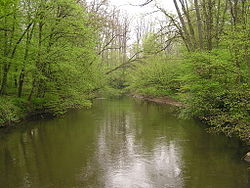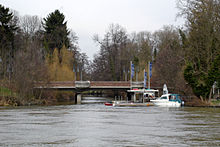| Kinzig | |
|---|---|
 Kinzig in the Bulau near Hanau | |
 Course of the Kinzig (interactive map) | |
| Location | |
| Country | Germany |
| State | Hesse |
| Reference no. | DE: 2478 |
| Physical characteristics | |
| Source | |
| • location | 500 m southwest of the village of Sinntal-Sterbfritz |
| • coordinates | 50°18′13″N 9°37′11″E / 50.303479°N 9.619721°E |
| • elevation | 400 m above sea level (NN) |
| Mouth | |
• location | West of the Altstadt of Hanau into the Main at river kilometre 55 |
• coordinates | 50°07′46″N 8°54′08″E / 50.129534°N 8.90222°E |
• elevation | 99 m above sea level (NN) |
| Length | 87.2 km (54.2 mi) [1] |
| Basin size | 1,058 km2 (408 sq mi) [1] |
| Discharge | |
| • location | [2][3] at its mouth |
| • average | 10.97 m³/s |
| Basin features | |
| Progression | Main→ Rhine→ North Sea |
| Landmarks |
|
| Tributaries | |
| • left | Ahlersbach(2478118), Auerbach, Ahlersbach(2478152), Klingbach, Orb, Bieber, Schandelbach, Birkigsbach, Hasselbach, Lache |
| • right | Ramholzer Wasser, Grennelbach, Elmbach, Riedbach, Steinaubach, Ulmbach, Salz, Bracht, Gründau, Fallbach |
| Waterbodies | Reservoirs: Kinzig-Stausee |
| Navigable | No (in the Middle Ages from Gelnhausen to its mouth) |
 Mouth in Hanau | |
The Kinzig is a river, 87 kilometres long, in southern Hesse, Germany. It is a right tributary of the Main. Its source is in the Spessart hills at Sterbfritz, near Schlüchtern. The Kinzig flows into the Main in Hanau. The Main-Kinzig-Kreis (district) was named after the river. The towns along the Kinzig are Schlüchtern, Steinau an der Straße, Bad Soden-Salmünster, Gelnhausen, and Hanau. The Kinzig is first recorded in 815 A.D. as Chinzicha.
This river played a part in the Battle of Hanau in October 1813, as Napoleon retreated back to the Rhine, after his defeat at the Battle of Leipzig.
There are several German rivers called Kinzig. Another Kinzig flows into the Rhine in Kehl-Auenheim
- ^ a b Water map service of the Hessian Ministry for the Environment, Energy, Agriculture and Consumer Protection (Hessisches Ministerium für Umwelt, Energie, Landwirtschaft und Verbraucherschutz)
- ^ Topographic map, 1:25,000 series and WRRL database
- ^ Pegelwert Hanau vermehrt um den Gebietsabfluss des Resteinzugsgebietes (137,08 km²), ermittelt aus den Daten der Pegel Rück, Hainstadt, Goldbach, Harreshausen, Alzenau, Hanau, Kleinheubach und Frankfurt a.M. Osthafen
